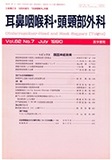Japanese
English
- 有料閲覧
- Abstract 文献概要
- 1ページ目 Look Inside
はじめに
鼻アレルギー症状発現の過程に自律神経反射が関与していることは古くより知られており,従って,鼻アレルギー患者における自律神経機能を調べた報告も数多くみられる。我々も,鼻アレルギー患者を対象として自律神経機能を検索して,交感神経系の反応性の低下と副交感神経系の反応性の亢進が存在していることを報告した1,2)。その後,これら自律神経系の反応性の変化が,ターゲット器官のレセプター数の変化としてとらえられるようになった3,4)。
ところで,これらの異常が,鼻アレルギー発症以前にすでに存在していたのか,あるいは逆に鼻アレルギーの結果として生じたものなのかは議論の別れるところである。しかし,その後,後天的鼻アレルギー動物モデルを用いた検討の結果,ヒトと同様の自律神経系レセプターの変化が証明されるに至り,鼻アレルギーの結果として自律神経系の変化が生じている可能性が強く示唆された4,5)。では実際に,鼻アレルギー症状発現の際には,自律神経活動自体は,どのようにご変化しており,前述のレセプターの変化とどのような関連を有しているのであろうか。そこで今回,鼻アレルギー発作時の交感神経系の機能的変化を調べる目的で,鼻誘発反応の際の指尖脈波(PTG)と心拍数の変化を調べた。
Changes of systemic autonomic nerve function after the nasal antigen provocation was studies by using plethysmograph (PTG). PTG was exa-mined at the nail of index finger. When thenasal symptoms were provoked by antigenic chal-lenge, the height of PTG waves decreased and the pulse rate increased significantly soon after occurrence of sneezing. These changes recovered gradually by 5 minutes after antigenic provocation. The similar changes of PTG and pulse rates were recognized after the nasal challenge with hista-mine and even with control disk when the nasal symptoms were provoked. These circulatory cha-nges were similar in quality but more pronounced in quantity than those recognized after the mental calculation.

Copyright © 1990, Igaku-Shoin Ltd. All rights reserved.


